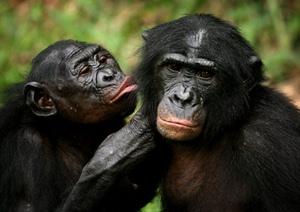Same sex relationships "common" in the natural world

At a time when societal acceptance of homosexuality is once again being scrutinised, John Holden looks at attitudes in the animal kingdom towards the gay members of the herd.
Even though it sounds odd for any scientific mind to simply ignore certain trends/behaviour/events within a field, many biologists and zoologists did just that for decades. Evidence of homosexual behaviour among animals has been documented in hundreds of species – from bees all the way up to our closest relative, the bonobo monkey – but the area has only been properly researched by experts in the last twenty years.
“For a long time people didn’t record homosexual interactions in animal behaviour or recorded them as mistakes,” explains Dr Mark Brown, Senior Lecturer in Biology at the Royal Holloway University of London. “Not recording it came from not knowing how to talk about it, or possibly from some buried moral reaction. This unfortunately is how the field has developed.
“If you exist in a world where homosexuality is considered wrong – even evil – you don’t go recording it in animals,” he adds. “Apart from anything else the scientists didn’t have the language to explain it. However, it’s now considered part of a normal expression of human behaviour.”
Now that research into the area is no longer taboo (in western countries anyway), experts have found an incredibly high proportion of this kind of behaviour throughout various species. A comprehensive guide is provided by Bruce Bagemihl in his book, Biological Exuberance where he cites homosexual behaviour in over 470 species. From insects basically trying to have sex with anything in a ‘practice makes perfect’ approach, to dolphins blowing into each other’s blowholes in their own form of oral aqua sex, Bagemihl shows homosexuality in animals is more common than first thought.
“A lot of insects will try and mate with anything,” says Brown. “Male bumblebees try and mate with queens from their own species, queens of other species, other males, and even with worker bees that can’t mate at all. One suggestion as to why this is the case is the strong selective pressure on males to mate and reproduce with something suitable. As long as there’s no huge cost in terms of mating with the wrong sex, there’s no reason not to try.”
Research does tend to suggest that homosexual tendencies are more common among male species. “If you look at it from a male/female perspective, from the data that’s out there, it does seem more frequent among males than females but that’s not always the case,” says Brown.
For example, homosexual behaviour between female Kobs (a type of antelope) is common, with no evidence to suggest the males get in on the act at all. Again some theories to explain it suggest that younger females do so to gain sexual experience. However, it is common among older females too. Female penguins are also known to partake in frequent homosexual encounters.
For human’s closest animal relative, the bonobo monkey (pictured above), homosexual behaviour is in fact more common than heterosexual behaviour, in both males and females. While other chimpanzee varieties use aggression and violence to solve problems in the colony, sex among certain bonobos is the preferred form of community engagement. “It’s like a social lubricant,” says Brown. “The best interpretation of this behaviour is that they’re using sex as a way of calming or controlling situations, as a means to diffusing tension and avoiding conflict.”
What’s also interesting is that there is no evidence to suggest that animals not partaking in homosexual behaviour have any problem with others doing it. Those partaking do not feel the need to go off and hide behind a tree nor are they shunned or punished by the others. “There’s no sense of deceit involved in animal sexual interaction,” says Brown. “There doesn’t seem to be any examples of animals being punished or ostracised for their behaviour.”
Can anything be learnt from our closest relative, the bonobo, about our own attitudes towards sexuality? “As a biologist, I’m wary of extrapolating anything from animals to humans,” stresses Brown. “But ironically it’s one of the few areas where it is harder to gauge trends amongst humans. With animals all we are doing is recording their behaviour. We’re not asking them to be honest, which is unfortunately still a feature of human research.”
Image Top: courtneybolton
